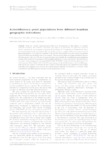Por favor, use este identificador para citar o enlazar este ítem:
http://www.alice.cnptia.embrapa.br/alice/handle/doc/1059343Registro completo de metadatos
| Campo DC | Valor | Lengua/Idioma |
|---|---|---|
| dc.contributor.author | SILVA, G. A. da | pt_BR |
| dc.contributor.author | AGUSTINI, B. C. | pt_BR |
| dc.contributor.author | MELLO, L. M. R. de | pt_BR |
| dc.contributor.author | TONIETTO, J. | pt_BR |
| dc.date.accessioned | 2016-12-27T11:11:11Z | pt_BR |
| dc.date.available | 2016-12-27T11:11:11Z | pt_BR |
| dc.date.created | 2016-12-27 | pt_BR |
| dc.date.issued | 2016 | pt_BR |
| dc.identifier.citation | BIO Web of Conferences, v. 7., n. 02030[online], 2016. | pt_BR |
| dc.identifier.uri | http://www.alice.cnptia.embrapa.br/alice/handle/doc/1059343 | pt_BR |
| dc.description | Yeasts are versatile microorganisms which show heterogeneity in their abilities of aromatic molecules formation. The metabolic conversions may improve the production of a particular compound already formed by the microorganism or promote the production of a completely new biochemicals. These conversions depend on the environment. The microbiome of terroir is unique. If the term terroir is a set of physical properties of a vineyard that contribute to the specific characteristics of its wine, the microorganisms will undoubtedly form an integral part of this concept. There are yeasts, filamentous fungi and bacteria that can affect the quality of the wine. The aim of the present study was to identify the autochthonous yeast populations of grape berries collected from regions with Geographic Indications or under construction. The identification was carried out by an approach, combining Maldi-Tof-MS, PCR-RFLP of the internal transcribed spacer with 5.8S ribosomal DNA (rDNA) (ITS1-5.8S-ITS2) and sequences of the D1/D2 domain of the 26S rRNA gene. Some species are common to different GIs and in some of them other species are completely absent, besides some places are contiguous areas. In some areas, Hanseniaspora opuntiae, Saccharomyces cerevisiae, Pichia myanmarensis and Hanseniaspora uvarum were the predominant species. | pt_BR |
| dc.language.iso | eng | eng |
| dc.rights | openAccess | eng |
| dc.subject | Terroir | pt_BR |
| dc.subject | Bagas de uva | pt_BR |
| dc.subject | Vinha | pt_BR |
| dc.subject | Indicação geográfica (IG) | pt_BR |
| dc.subject | Pichia Myanmarensis | pt_BR |
| dc.subject | Populações de leveduras | pt_BR |
| dc.subject | Autochthonous yeast | pt_BR |
| dc.title | Autochthonous yeast populations from different brazilian geographic indications. | pt_BR |
| dc.type | Artigo de periódico | pt_BR |
| dc.date.updated | 2019-05-06T11:11:11Z | pt_BR |
| dc.subject.thesagro | Vinho | pt_BR |
| dc.subject.thesagro | Saccharomyces Cerevisiae | pt_BR |
| dc.subject.nalthesaurus | Yeasts | pt_BR |
| dc.subject.nalthesaurus | Hanseniaspora uvarum | pt_BR |
| dc.subject.nalthesaurus | Hanseniaspora opuntiae | pt_BR |
| dc.description.notes | Também publicado em: CONGRESSO MUNDIAL DA VINHA E DO VINHO, 39., 2016, Bento Gonçalves. Programa...Bento Gonçalves, RS: International Organisation of Vine and Wine (OIV): Ministério da Agricultura, Pecuária e Abastecimento, de 19 a 21 outubro, 2016. Artigo nº 7, 02030. 2016. | pt_BR |
| riaa.ainfo.id | 1059343 | pt_BR |
| riaa.ainfo.lastupdate | 2019-05-06 -03:00:00 | pt_BR |
| dc.identifier.doi | 10.1051/bioconf/20160702030 | pt_BR |
| dc.contributor.institution | GILDO ALMEIDA DA SILVA, CNPUV; BRUNA CARLA AGUSTINI, CNPUV; LOIVA MARIA RIBEIRO DE MELLO, CNPUV; JORGE TONIETTO, CNPUV. | pt_BR |
| Aparece en las colecciones: | Artigo em periódico indexado (CNPUV)  | |
Ficheros en este ítem:
| Fichero | Descripción | Tamaño | Formato | |
|---|---|---|---|---|
| Gildobioconfoiv201602030.pdf | 165.51 kB | Adobe PDF |  Visualizar/Abrir |









